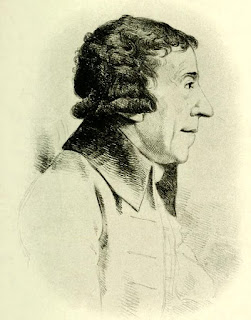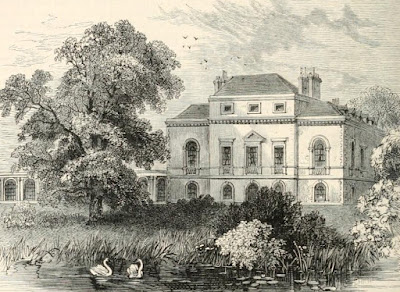 |
| Lady Craven by Romney from Romney by R Davies (1914) |
Profile
Elizabeth, Margravine of Brandenburg-Ansbach-Bayreuth, previous married name Lady Craven (17 December 1750 – buried 13 January 1828), was a playwright and author, notorious for her scandalous affairs during her first marriage to Lord Craven.
Early years
Elizabeth Berkeley was born on 17 December 1750, the youngest daughter of Augustus Berkeley, 4th Earl of Berkeley, and his wife, Elizabeth Drax of Charborough in Dorset.
The infamous Lady Craven
 |
| William Craven, 6th Baron Craven, from The Beautiful Lady Craven, Lady Craven's memoirs edited by AM Broadley and L Melville (1914) |
The marriage, however, was not a success. Both Elizabeth and her husband indulged in affairs, notably Elizabeth’s scandalous liaison with the French ambassador, the Count of Guines, in 1773, which even made it into the pages of the Morning Chronicle.
 |
| The Count, afterwards the Duke, of Guines, from The Beautiful Lady Craven, Lady Craven's memoirs edited by AM Broadley and L Melville (1914) |
Elizabeth became friends with Horace Walpole, corresponding with him and visiting his home at Strawberry Hill. Some of her early work was published on the Strawberry Hill Press. During this period, she wrote a satire on German snobbery and several plays, including The Miniature Picture, which was put on at Drury Lane in 1780/1.
 |
| Horace Walpole from The Beautiful Lady Craven, Lady Craven's memoirs edited by AM Broadley and L Melville (1914) |
Whilst Lord Craven tolerated Elizabeth’s behaviour, she was still received in society, but in 1783, Lord Craven had had enough. He arranged a separation, giving Elizabeth a settlement of £1,500 a year.
Travel and intrigues
 |
| Lady Craven and her son, from The Beautiful Lady Craven, Lady Craven's memoirs edited by AM Broadley and L Melville (1914) |
At the suggestion of Horace Walpole, Elizabeth published the story of her travels, A Journey through the Crimea to Constantinople (1789), her most popular work.
 |
| Lady Craven and the Margrave of Anspach from The Beautiful Lady Craven, Lady Craven's memoirs edited by AM Broadley and L Melville (1914) |
In 1787, Elizabeth visited her long-time correspondent, the Margrave of Ansbach, and successfully displaced his mistress in his affections. Together they travelled to Berlin to arrange the sale of the Margrave’s principality to the King of Prussia for a very handsome sum. The Margrave’s ailing wife died in early 1791, and Lord Craven followed suit in September. Less than a month later, on 13 October 1791, Elizabeth married the Margrave in Lisbon with great style.
 |
| The Margrave of Anspach from The Beautiful Lady Craven, Lady Craven's memoirs edited by AM Broadley and L Melville (1914) |
Elizabeth and the Margrave travelled to England and bought a house in Fulham overlooking the Thames which they called Brandenburg House. If Elizabeth had hoped that her wealth and position would see her past indiscretions forgotten, she was to be disappointed.
The Bon Ton in March 1792 said:
The Margravine of Anspach is not visited by any of the leading Ladies of Fashion, although she had not been wanting in sending round her cards of invitation, and calling at their houses. At a ball given at her house a few nights since, to which there was a general invitation, only thirty people of both sexes were present.1
It must have been an even greater blow to Elizabeth that she was not received at court. George III disapproved of her marriage, thinking it unequal – the Margrave was a member of the Prussian royal family and Elizabeth was only the daughter of an earl. The King refused to recognise the title of Princess Berkeley that the Holy Roman Emperor Francis II had bestowed on her.
Despite these setbacks, Elizabeth entertained lavishly at Brandenburg House and frequently put on plays in the little theatre near the house.
Around 1799, the Margrave bought Benham Park, near Newbury in Berkshire, the country seat of the Cravens. The Margrave took a keen interest in horseracing and bred horses at Benham.
The Margrave died quite suddenly on 5 January 1806 leaving his wife a fortune of around £150,000. Elizabeth erected a huge memorial to him near Benham, on the Bath Road.
The widowed Margravine continued to divide her time between Benham Park and Brandenburg House with occasional trips to Europe.
The Persian ambassador
 |
| Mirza Abul Hassan Khan by Sir Thomas Lawrence (1810) in Fogg Art Museum Photo by Daderot CCO via Wikimedia Commons |
The ambassador was back at Brandenburg House on 6 April 1810, during the London riots over Sir Francis Burdett’s arrest. He noted that two of the Margravine’s guests, Lord Keith and his daughter Margaret Mercer Elphinstone, arrived covered with mud, because the rioters had pelted them with stones for refusing to remove their hats.
On 16 May, he was invited to experience the Brandenburg House Theatricals:
Brandenburgh House Theatre was opened yesterday for the first time since the death of the Margrave. Miss Jane Cramer’s performance was much admired. The Persian Ambassador was in the fashionable circle, and the Duke of Kent’s Band attended.3
Queen Caroline and the end of Brandenburg House
In June 1820, Caroline, Princess of Wales, the estranged wife of George IV, returned to England to claim her position as Queen Consort of England. Elizabeth lent Brandenburg House to Queen Caroline, and it was here that Caroline died on 7 August 1821, having failed in her attempt to be crowned Queen. The following February, Elizabeth commissioned the sale of furniture, china and books at Brandenburg House, and in May, the fabric of the building was sold off, including staircases, chimney pieces, doors, windows, and the scenery and machinery of the theatre.
Villa Craven
In June 1820, Caroline, Princess of Wales, the estranged wife of George IV, returned to England to claim her position as Queen Consort of England. Elizabeth lent Brandenburg House to Queen Caroline, and it was here that Caroline died on 7 August 1821, having failed in her attempt to be crowned Queen. The following February, Elizabeth commissioned the sale of furniture, china and books at Brandenburg House, and in May, the fabric of the building was sold off, including staircases, chimney pieces, doors, windows, and the scenery and machinery of the theatre.
Villa Craven
Elizabeth was living in Villa Craven, her house in Naples, when she wrote her colourful memoirs which were published in 1826. She died two years later and was buried in the British cemetery at Naples on 13 January 1828.
 |
| The tomb of the Margravine of Anspach, Naples, from The Beautiful Lady Craven, Lady Craven's memoirs ed by AM Broadley and L Melville (1914) |
Notes
(1) From Craven, Elizabeth Craven, Baroness, The beautiful Lady Craven edited by AM Broadley and Lewis Melville (1914). Ansbach was sometimes spelt Anspach as in this article.
(2) From Hassan Khan, Mirza Abul, A Persian at the Court of King George 1809-10, edited by Margaret Morris Cloake (1988).
(3) From Craven, Elizabeth Craven, Baroness, The beautiful Lady Craven edited by AM Broadley and Lewis Melville (1914). Brandenburg was sometimes spelt Brandenburgh as in this book.
Sources used include:
Davies, Randall, Romney (1914)
Courthope, William, editor, Debrett's Complete Peerage of the United Kingdom of Great Britain and Ireland (1838)
Craven, Elizabeth Craven, Baroness, later Margravine of Brandenburg-Ansbach-Bayreuth, The Beautiful Lady Craven edited by AM Broadley and Lewis Melville (1914)
Hassan Khan, Mirza Abul, A Persian at the Court of King George 1809-10, edited by Margaret Morris Cloake (1988)
Turner, Katherine, Elizabeth, Margravine of Brandenburg-Ansbach-Byreuth (other married name Elizabeth Craven, Lady Craven) (1750-1828) Oxford Dictionary of National Biography (Oxford University Press, 2004; online edition May 2010; accessed 9 June 2017)
Walford, Edward, Old and New London: A narrative of its history, its people, and its places (Cassell, Petter & Galpin, 1878, London) Vol 6LBHF Libraries blog: The end of Brandenburg House


Interesting!!
ReplyDeleteGreat post! I love the bit about the Persian ambassador.
ReplyDeleteFor more details about Craven's life and remarkable writings see Elizabeth Craven: Writer, Feminist and European, (Vernon Press. 2017)
https://vernonpress.com/title?id=334
Elizabeth Drax was from Charborough (not Charlborough)Park, between Sturminster Marshall & Bere Regis. https://en.wikipedia.org/wiki/Charborough_House
ReplyDeleteThanks for pointing out my typo - I've now corrected it.
DeleteThank you for sharing! Lady Craven was my cousin's wife. It's been fun to discover her on my genealogical journey.
ReplyDelete